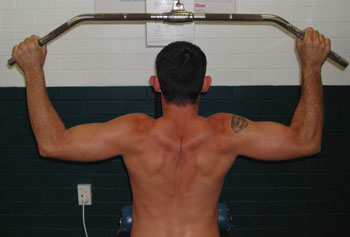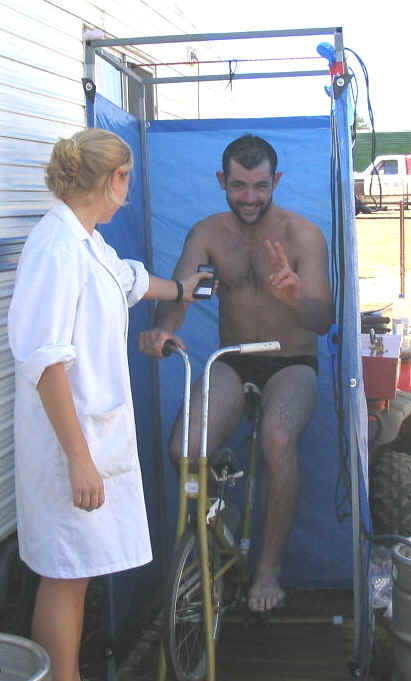|
An analysis of data from Dwayne Black’s 9-hour WORLD RECORD 05-04-05 Heat stress and intense physical exercise |
|||
|
The air temperature in the Kojonup region on Tuesday 4th April 2005, during Dwayne’s 12-hour day in the shed was recorded at 30oC (http://australianweathernews.com/data/DE1_10A.HTM). This, combined with the electric heat generators labouring all day to ensure the sheep were kept in optimal shearing condition, would have led to shed temperatures in excess of the average underground mine temperatures. Dwayne’s accomplishment was considerably more notable since he performed, under severe temperatures, repeated bouts of extreme physical work for long periods of time. Such attempts to push the body to its physical limits in severe heat were witnessed by many in the Athens Olympic Games of 2004 to cause fellow WR holder Paula Radcliffe to collapse; for Portuguese marathon runner Lazaro, the heat of the 1912 games was fatal. Fluid loss and performance An analysis of the data collected during the first of Dwayne’s five shearing sessions highlights the remarkable work intensity that was maintained throughout this 2-hour period from 5 to 7 am. 112 sheep were shorn and Dwayne’s heart rate was elevated to an average of 158 beats per minute, which translates to 84% of his estimated maximum heart rate. His body mass decreased by 3.0 kg and he ingested 2.5 litres of fluids, resulting in a total fluid loss, primarily due to sweating, of 5.5 litres. This would be similar to the fluid losses experienced by elite marathon runners such as Stefano Baldini, Paul Tergat and Vanderlei de Lima during competition also lasting around 2 hours (McArdle et al., 1996). Dwayne’s total fluid loss corresponds to a rate of approximately 46 ml per min. |
 |
||
|
|||
|
Exercise intensity and physiological responses |
|||
|
Lance Armstrong will spend the majority of his days during the Tour de France working at his lactate threshold: that is, at an intensity that prevents an excessive build-up of lactate in the working muscles. At his lactate threshold, Armstrong is working at an equivalent of 76 – 85% of his maximal oxidative capacity (VO2max) (Coyle, in press). While we do not currently have a measure of Dwayne’s VO2max, we know that he spent 9 hours working at 72 – 84% of his maximal heart rate, which is an alternative measure of relative work intensity. Furthermore, it appears from his post-session lactate measures (3.3 – 4.0 mmol per litre) that he would have been working close to his lactate threshold. Laboratory tests scheduled to take place this week in the School of Human Movement at UWA will determine both VO2max and lactate threshold values for Dwayne. |

|
||
| However, even without these measures it seems fair to suggest that for the duration of Tuesday’s sheep-shearing record, he would have been working at similar relative intensities as Armstrong does during a day on the world’s most gruelling road cycling race, the Tour de France.
Calorific output The daily energy cost of an average shearer, who completes around 250 sheep in an 8-hour day, has been calculated to be in excess of 5,000 kilocalories (Stuart et al., unpublished). This is beyond the maximal permissible limit for daily energy output for men working at the same task on a year-round basis, suggested at 4,800 kilocalories. Compared with these figures, Dwayne’s potential energy output becomes quite astounding. If we double the energy expenditure during his shearing hours (since he completed more than double the number of sheep compared with the average shearer used in the above example), and add a constant for basal metabolism, his energy cost for the day could have been around 8,000 kilocalories. This is greater than the energy expenditures of males following a 45-km ski-alpinism race (alternating up- and down-hill running and cross country skiing), which lasted 7 h 21 min, and a 100-km ultramarathon race, which lasted 15 h 27 min, where the estimated energy expenditures were 5,000 and 7,000 kilocalories, respectively (Zaccaria et al., 2002). Dwayne’s food intake was reasonably low over the course of the day, probably due to the intense nature of the task and the extremely hot conditions in the shed. Since carbohydrate intake is directly related to the performance of enduring athletic events as displayed by Ironman athletes (Kimber and Ross, 2002), it may be possible to produce further improvements in performance through a carefully prescribed dietary plan. References Bangsbo, J. (1993). The physiology of soccer - with special reference to intense intermittent exercise. Copenhagen, HO+Storm. Brake, D. J. and G. P. Bates (2002). "Fluid losses and hydration status of industrial workers under thermal stress working extended shifts." Occupational and Environmental Medicine 60: 90-96. Coyle, E. F. (in press). "Improved muscular efficiency displayed as 'Tour de France' champion matures." Journal of Applied Physiology. Culvenor, J., S. Cowley, R. Freeman, J. Harvey, M. Lawrance, K. McElroy, W. Payne, J. Pryor, D. Stuart and R. Williams (1997). The ergonomics of sheep shearing. International Workplace Health and Safety Forum and 33rd Ergonomics Society of Australia Conference, Gold Coast. Duffield, R., B. Dawson, D. Bishop, M. FitzSimons and S. Lawrence (2003). "Effect of wearing an ice cooling jacket on repeat sprint performance in warm/humid conditions." British Journal of Sports Medicine 37(2): 164-169. Harvey, J., J. Culvenor, W. Payne, S. Cowley, M. Lawrance, D. Stuart and R. Williams (2002). "An analysis of the forces required to drag sheep over various surfaces." Applied Ergonomics 33(6): 523-531. http://australianweathernews.com/data/DE1_10A.HTM. http://www2b.abc.net.au/sport/forum/newposts/7/topic7134.shtm. Kimber, N. E. and J. J. Ross (2002). "Energy balance during an ironman triathlon in male and female triathletes." International Journal of Sport Nutrition and Exercise Metabolism 12(1): 47-62. McArdle, W., F. Katch and V. Katch (1996). Exercise physiology: energy, nutrition and human performance. Baltimore, Williams and Wilkins. Reilly, T. (1996). Science and Soccer. London, E & FN Spon. Stuart, D., W. Payne, H. Askari, S. Cowley, J. Culvenor, R. Freeman, R. Hall, J. Harvey, M. Lawrance, K. McElroy, J. Pryor and R. Williams (unpublished). Sheepshearing in Australia - some identified problems with practical answers. Toowoomba. Zaccaria, M., A., A. Ermolao, G. S. Roi, P. Englaro, G. Tegon and M. Varnier (2002). "Leptin reduction after endurance races differing in duration and energy expenditure." European Journal of Applied Physiology 87(2): 108-111. |
|||

